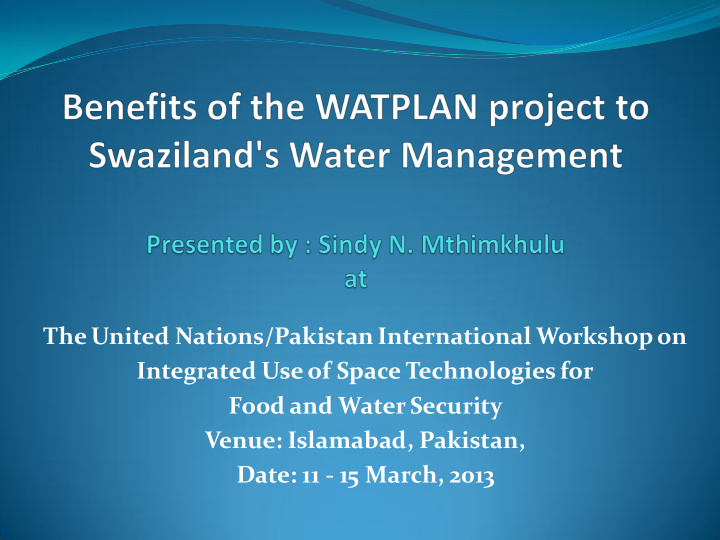



The United Nations/Pakistan International Workshop on Integrated Use of Space Technologies for Food and Water Security Venue: Islamabad, Pakistan, Date: 11 - 15 March, 2013
OUTLINE WATPLAN- origins & methodology The shared Incomati basin Why WATPLAN- capabilities & applicability Water use in Swaziland Potential benefits of WATPLAN Taking WATPLAN forward
The WATPLAN PROJECT A tool for spatial earth observation monitoring for planning and water allocation in the INCOMATI basin An operational earth observation monitoring system An online state of the art near real-time monitoring system Monitoring based on satellite images and ground measurements Water and biomass related indicator data updated weekly through a website accessible to registered stakeholders
The WATPLAN PROJECT A demonstration project funded by EU- from Feb 2011 – June 2013 Combined forces from 7 specialist institutions Data generation- SEBAL model used (developed and owned by eLEAF based at Wagenigen university) Rainfall derived thru- microwave data from FEWS- NET sensors with in- situ rainfall data Crop yield estimates from biomass production estimates Data disseminated using internet based portal- an operational monitoring website www.watplan.com
THE INCOMATI BASIN
TRANSBOUNDARY COOPERATION
LOCALISED BASIN MAP
INCOMATI BASIN CHARACTERISTICS Situated in the south-eastern corner of the African continent Shared between South Africa, Swaziland, and Mozambique Water use intense- : 50 % of the water generated in the basin being withdrawn Water scarcity evident since the mid-1980s, becoming more severe in the last decade. Effects of droughts & floods, ever more pronounced
WHY WATPLAN?? Competition over water is real in INCOMATI, and water abstractions are fast approaching limits of sustainability. Equitable and efficient water allocation requires transparent and rational decision making, based on objective and regular monitoring. Good quality data and monitoring systems are lacking Quantitative, objective and regular measurements needed.
WHY WATPLAN?? Remote sensing technologies used to provide objective and high quality data on a regular basis. WATPLAN developed as a tool to support transparent and rational decision making on water allocation, verification of water use and sustainable water utilisation. Tool provides information which increases knowledge & can be incorporated into latest technology and water modeling applications
COMPONENTS PROVIDED Actual Evapotranspiration (mm/week) Biomass production (kg/ha/week) Precipitation (mm/week) Precipitation – Evapotranspiration (mm/week) Spatial resolution: 30 * 30 meter Temporal resolution: weekly
SWAZILAND’S WATER USE PROFILE Agro based economy (highest contributor to GDP) Irrigation takes 96 % of available water resources Sugar cane , the dominant crop Intensive farming systems employed Monitoring of performance of irrigation systems important Water allocation across sectors key Need to ensure beneficial & efficient utilisation of available water resources Exotic Forest Plantations another income generator Need to understand stream flow reduction impacts of exotic forestry
SWAZILAND’S WATER USE IN THE KOMATI Large and small scale sugarcane plantations exist (15 000 ha) Shared Maguga dam located in this basin and requires accurate water releases and accounting Forestry, a major economic activity in the basin Decentralisation- The Komati RBA has to plan developments, operate the river and allocate & monitor all water diversions from the river in a manner that meets transboundary obligations.
IMPORTANCE TO SWAZILAND’S WATER MANAGEMENT Water allocation and verification of water use. Calculation of water balances Determines actual water use up to farm level Independent verifiable information generated (creates trust amongst stakeholders) Ensures equitable and efficient water allocation. Key for sustainable utilisation of water Monitoring of hydro- meteorological parameters Data used in designs of water infrastructure Water resources and land use planning
BENEFITS OF WATPLAN TO SWAZILAND Compare water use efficiency in agriculture Across different hydrometric regions Between production and irrigation systems Estimates biomass production to assist to determine water use efficiency Compare water consumption across different biophysical areas of interest Quantify water consumption / requirements weekly Quantify water use by forestry Estimate environmental water requirements
WATER CONSUMPTION Biomass production (Kg/ha/day)
BENEFITS OF WATPLAN TO SWAZILAND Provide useful information for irrigation scheduling Information on when to irrigate How much water required Which pump to switch when and for how long Biomass production info useful in estimating fertilizer application rates and useful in drought monitoring Monitoring compliance to Treaties
BENEFITS OF WATPLAN TO SWAZILAND Data generation Weekly generation of evapotranspiration data Biomass production data Rainfall data Correlation of rainfall and evapotranspiration data Land cover information Feed reliable data to rainfall- runoff models Ensure better water allocation and assist in water accounting Verification of water use, monitoring water licensing compliance Overall sustainable water utilisation
CROP DEVELOPMENT Evapotranspiration (mm/day)
MOVING FORWARD WATPLAN is a demonstration project- ending soon Data acquisition is not cheap Need for data application to show value addition of the WATPLAN products Need for joint roll out of transboundary projects to utilise the generated data (opportunity for cost sharing) Capacity building
….END…. THANK YOU
Recommend
More recommend